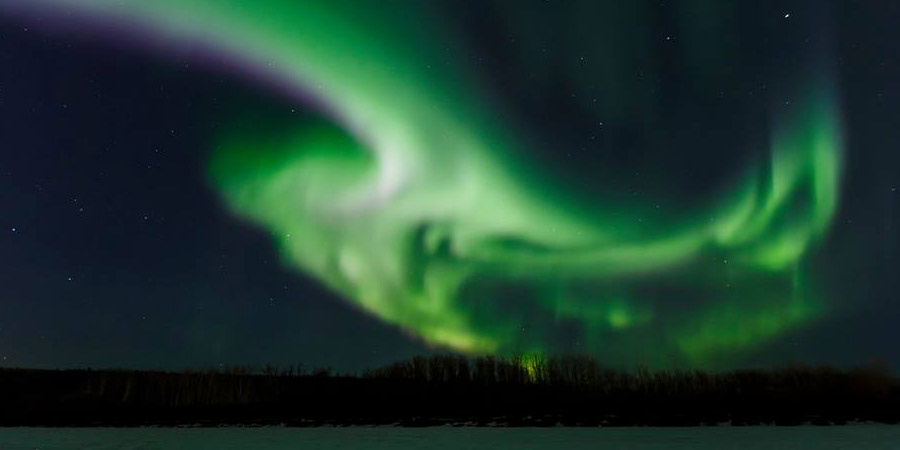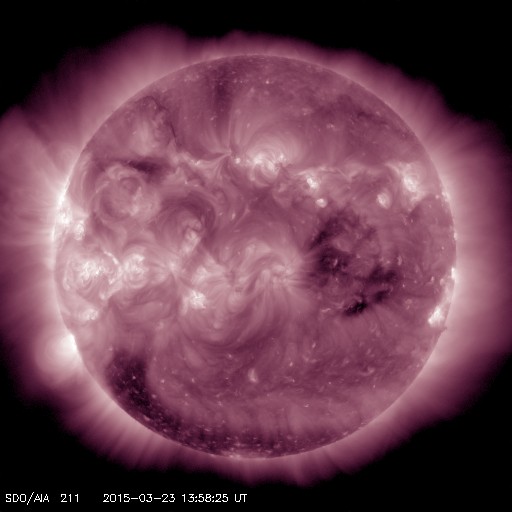Geomagnetic unrest, quiet Sun
Monday, 23 March 2015 14:59 UTC

Geomagnetic activity has been elevated every since the impact of the C9 coronal mass ejection that sparked a severe G4 geomagnetic storm and produced auroral displays at many middle latitude locations. Be sure to check out our news item from a few days ago that is filled with amazing aurora imagery from all around the world. Thank you everyone for sending in your images and videos!
Header image: Aurora Borealis captured two nights ago in Canada by Tracy Holland Photography.
Geomagnetic unrest
It is interesting to note that the geomagnetic conditions never really settled down to quiet levels over the past few days as the C9 coronal mass ejection was followed by a coronal hole high speed solar wind stream that still influences Earth right now. Geomagnetic conditions actually managed to reach the moderate G2 geomagnetic storm level (as reported by the NOAA SWPC) yesterday as the coronal hole high speed solar wind stream continues to batter the magnetic field surrounding our planet.
This solar wind stream should die down in the days ahead as the coronal hole responsible for this activity is no longer facing Earth. A southern hemisphere polar coronal hole with a northward extension is now rotating into view but it could still take at least 5 days before this solar wind stream reaches Earth. We can conclude that coronal hole solar wind stream effects should lessen in the days ahead and the geomagnetic conditions will likely slowly fall back to quiet levels until the next high speed solar wind stream arrives. Occasional upticks up to Kp4 (active geomagnetic conditions) are still possible due to the elevated speed of the solar wind.

Image: Our Sun in the 211 Ångström wavelength showing coronal holes as dark areas in the solar atmosphere.
Quiet Sun
The Sun has quieted down considerably ever since sunspot region 2297 departed the Earth-facing solar disk. Solar activity is struggeling to reach low levels (C-class activity) as none of the sunspot regions on the disk right now are complex enough to produce strong solar flares. Solar activity will likely be very low (B-class) to low (C-class) in the foreseeable future. More complex sunspot regions are needed if we wish to reach the M-class solar activity. Visit this page for an overview of the current sunspot regions.
Thank you for reading this article! Did you have any trouble with the technical terms used in this article? Our help section is the place to be where you can find in-depth articles, a FAQ and a list with common abbreviations. Still puzzled? Just post on our forum where we will help you the best we can!
Latest news
Latest forum messages
Support SpaceWeatherLive.com!
A lot of people come to SpaceWeatherLive to follow the Sun's activity or if there is aurora to be seen, but with more traffic comes higher server costs. Consider a donation if you enjoy SpaceWeatherLive so we can keep the website online!

Space weather facts
| Last X-flare | 2025/03/28 | X1.1 |
| Last M-flare | 2025/04/01 | M2.4 |
| Last geomagnetic storm | 2025/03/27 | Kp5 (G1) |
| Spotless days | |
|---|---|
| Last spotless day | 2022/06/08 |
| Monthly mean Sunspot Number | |
|---|---|
| February 2025 | 154.6 +17.6 |
| Last 30 days | 128.1 -22.5 |


